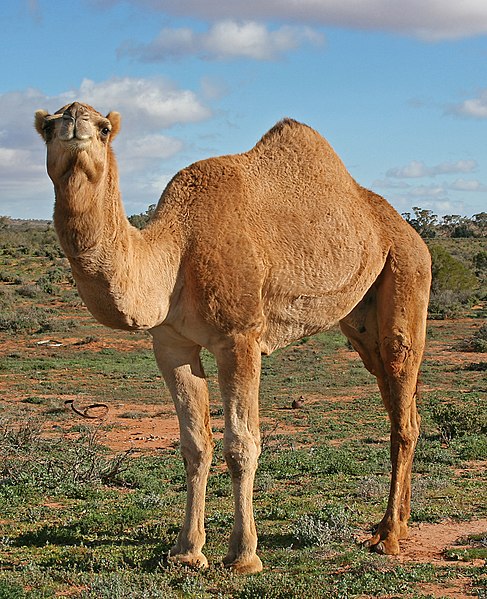Camall
[Genus: Camailla]
A camall (/ˈka.məl/), genus Camailla, is a large cloven-hoofed herbivorous mamacha, native to the arid regions of southern and far eastern Heberia, easily recognized for its uniquely humped back. There are three extant species of Camall. The Janubian camall, or Dromadaire (Camalla dromadairaigh) has one hump, while the Barakien camall (Camalla barakaigh) and the Eastern wild camall (Camalla allta) have two.
Camalls are light brown in color with massive, humped torsos, short tails, long slender legs, and elongated necks that dip down before rising to support a small narrow head with a prominent snout. Full grown male Janubian camalls stand just over 2.1 yards tall at the shoulder and 2.6 yards at the hump, weighing 1000 – 1500 punds. Eastern and Barakien camalls can be up to .4 yards taller and 500 – 700 punds heavier. They also tend to be darker in color, more muscular and have a woolier hide. Females of all three species are slightly smaller than males. They can live as long as 60 – 75 years.
Often referred to as “ships of the desert,” camalls are known for their ability to travel for extended periods over extremely long distances without water, and have been domesticated as pack and saddle animals for thousands of years. Camalls can travel at sustained speeds of 18 mpu, and run in short bursts as fast as 30 mpu, while carrying between 400 and 600 punds on their backs, depending upon the species. They also provide food in the form of meat and milk, and textiles in the form of fiber and felt made from the hair of their thick coats.
In addition to their humps, which consist of stored fat that can be metabolized when food and water are scarce, camalls have other unique genetic adaptations that allow them to thrive in hot arid conditions. They have a third transparent eyelid, and two rows of long lashes to prevent blowing sand from harming their eyes, and are able to shut their nostrils during sandstorms. They have thick callous pads on their chest and knees for protection against the scorching heat of desert sands, and their thick leathery lips and mouth cavities allow them to consume thorny plants such as nettles, saltbush and cactasi.
Camalls were first domesticated 5,000 to 6,000 years ago in eastern Heberia, and have played a significant role in the development of human culture there and in the Jeneb ever since. The entire economies of many early societies were dependent upon the camall. Its milk and meat were food staples. Its hair and hide were used for clothing and shelter. Its strength and endurance expanded the range and mobility of primitives peoples and allowed for the development of trade across otherwise impassable expanses. It is no wonder that the camall is celebrated by many eastern cultures in story and song, and depicted in art and sculpture.
To be continued...



Comments